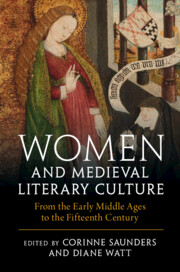Book contents
- Women and Medieval Literary Culture
- Women and Medieval Literary Culture
- Copyright page
- Contents
- Illustrations
- Contributors
- Acknowledgements
- Introduction
- I Patrons, Owners, Writers, and Readers in England and Europe
- II Circles and Communities in England
- III Health, Conduct, and Knowledge
- Chapter 7 Embracing the Body and the Soul
- Chapter 8 Gender and Class in the Circulation of Conduct Books
- Chapter 9 Women’s Learning and Lore
- Chapter 10 Women and Devotional Compilations
- IV Genre and Gender
- V Women as Authors
- General Index
- Index of Manuscripts
- References
Chapter 7 - Embracing the Body and the Soul
Women in the Literary Culture of Medieval Medicine
from III - Health, Conduct, and Knowledge
Published online by Cambridge University Press: 28 July 2023
- Women and Medieval Literary Culture
- Women and Medieval Literary Culture
- Copyright page
- Contents
- Illustrations
- Contributors
- Acknowledgements
- Introduction
- I Patrons, Owners, Writers, and Readers in England and Europe
- II Circles and Communities in England
- III Health, Conduct, and Knowledge
- Chapter 7 Embracing the Body and the Soul
- Chapter 8 Gender and Class in the Circulation of Conduct Books
- Chapter 9 Women’s Learning and Lore
- Chapter 10 Women and Devotional Compilations
- IV Genre and Gender
- V Women as Authors
- General Index
- Index of Manuscripts
- References
Summary
This essay addresses women and medicine in the Middle Ages, especially works concerning the female body and reproduction. Positive representations of the female body are found in the mystical writings of, for example, the thirteenth-century nuns of Helfta and Mechthild of Hackeborn, and, in contrast to later gynaecological works, which were often deeply misogynistic, Hildegard of Bingenߣs medical texts ascribe a redemptive quality to womenߣs reproductive processes. Most medical treatises, however, were not written for women, and even women involved in health care, including midwives, had little access to them. The Trotula, a compendium on womenߣs medicine taking its name from the twelfth-century woman physician Trota, was widely disseminated and translated as a whole and in parts, but although early Latin versions were addressed to women, later versions were owned largely by men. Nevertheless, there is some evidence of female readership and audiences, and the translation of medical treatises about women into the vernacular increased womenߣs access to this important form of textual knowledge.
Keywords
- Type
- Chapter
- Information
- Women and Medieval Literary CultureFrom the Early Middle Ages to the Fifteenth Century, pp. 141 - 159Publisher: Cambridge University PressPrint publication year: 2023



